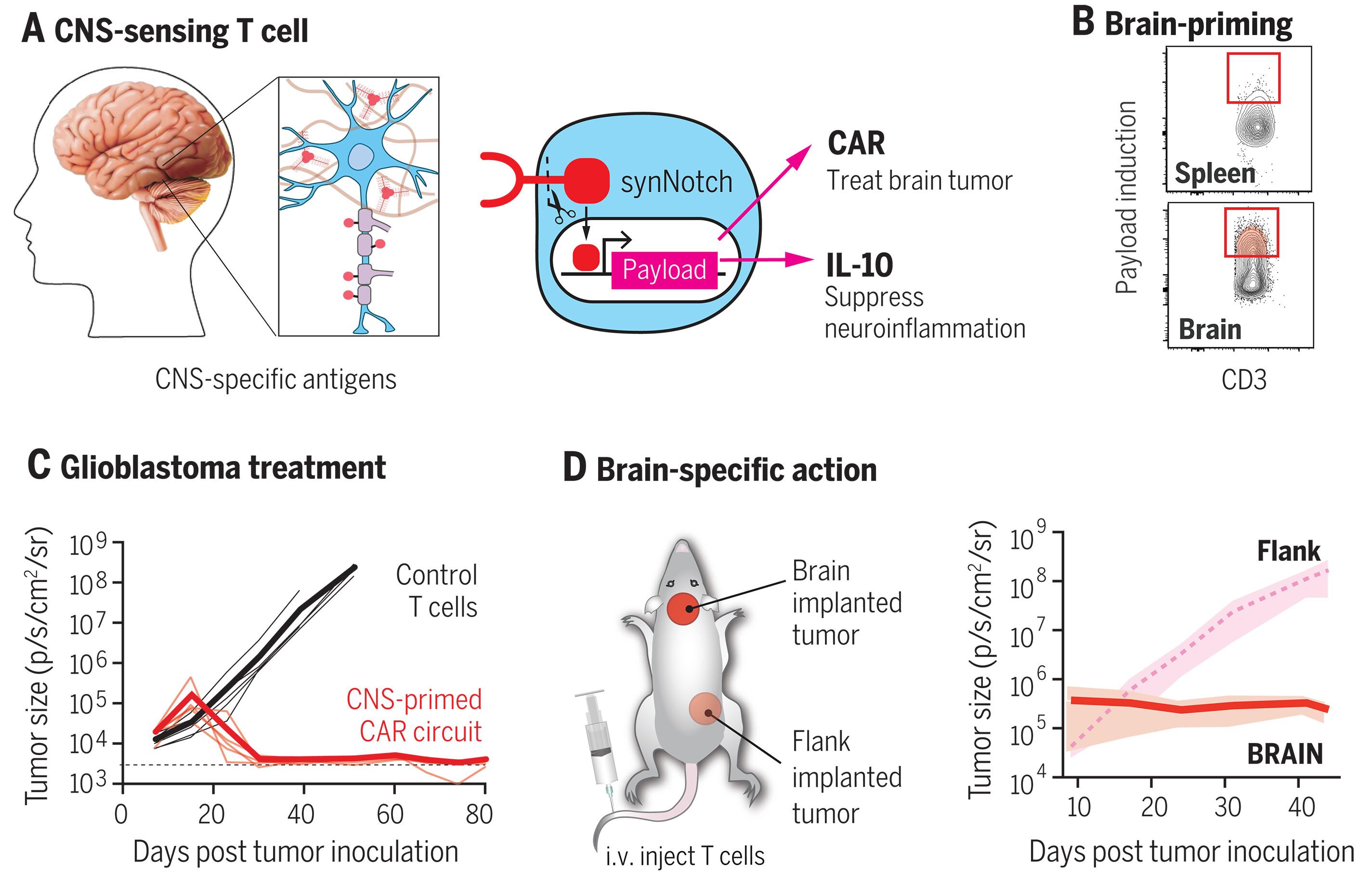编程组织感应T细胞,将治疗方法传递给大脑
IF 45.8
1区 综合性期刊
Q1 MULTIDISCIPLINARY SCIENCES
引用次数: 0
摘要
为了设计能够特异性靶向中枢神经系统(CNS)的细胞,我们鉴定了细胞外中枢神经系统特异性抗原,包括中枢神经系统细胞外基质的成分和在神经元或胶质细胞上表达的表面分子。用于检测这些抗原的合成Notch受体被用于编程T细胞,仅在大脑中诱导不同有效载荷的表达。诱导嵌合抗原受体表达的cns靶向T细胞有效清除原发性和继发性脑肿瘤,而不损害脑外交叉反应细胞。相反,局部递送免疫抑制细胞因子白介素-10的中枢神经系统靶向细胞可改善小鼠神经炎症模型的症状。组织感应细胞代表了一种以解剖学为目标的方式解决各种疾病的策略。本文章由计算机程序翻译,如有差异,请以英文原文为准。

Programming tissue-sensing T cells that deliver therapies to the brain
To engineer cells that can specifically target the central nervous system (CNS), we identified extracellular CNS-specific antigens, including components of the CNS extracellular matrix and surface molecules expressed on neurons or glial cells. Synthetic Notch receptors engineered to detect these antigens were used to program T cells to induce the expression of diverse payloads only in the brain. CNS-targeted T cells that induced chimeric antigen receptor expression efficiently cleared primary and secondary brain tumors without harming cross-reactive cells outside of the brain. Conversely, CNS-targeted cells that locally delivered the immunosuppressive cytokine interleukin-10 ameliorated symptoms in a mouse model of neuroinflammation. Tissue-sensing cells represent a strategy for addressing diverse disorders in an anatomically targeted manner.
求助全文
通过发布文献求助,成功后即可免费获取论文全文。
去求助
来源期刊

Science
综合性期刊-综合性期刊
CiteScore
61.10
自引率
0.90%
发文量
0
审稿时长
2.1 months
期刊介绍:
Science is a leading outlet for scientific news, commentary, and cutting-edge research. Through its print and online incarnations, Science reaches an estimated worldwide readership of more than one million. Science’s authorship is global too, and its articles consistently rank among the world's most cited research.
Science serves as a forum for discussion of important issues related to the advancement of science by publishing material on which a consensus has been reached as well as including the presentation of minority or conflicting points of view. Accordingly, all articles published in Science—including editorials, news and comment, and book reviews—are signed and reflect the individual views of the authors and not official points of view adopted by AAAS or the institutions with which the authors are affiliated.
Science seeks to publish those papers that are most influential in their fields or across fields and that will significantly advance scientific understanding. Selected papers should present novel and broadly important data, syntheses, or concepts. They should merit recognition by the wider scientific community and general public provided by publication in Science, beyond that provided by specialty journals. Science welcomes submissions from all fields of science and from any source. The editors are committed to the prompt evaluation and publication of submitted papers while upholding high standards that support reproducibility of published research. Science is published weekly; selected papers are published online ahead of print.
 求助内容:
求助内容: 应助结果提醒方式:
应助结果提醒方式:


